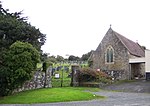Instow

Instow is a village in north Devon, England. It is on the estuary where the rivers Taw and Torridge meet, between the villages of Westleigh and Yelland and on the opposite bank to Appledore. There is an electoral ward with the same name. The ward's total population at the 2011 census was 1,501. There is a small river beach and sand dunes, that home some rare species of orchid including the pyramid orchid.The Tarka Trail passes through Instow, providing an easy means for people to arrive on foot or by bike. This section of the Trail is also part of the South West Coast Path, offering longer walks along the coast. The village is served by the Church of St John the Baptist, which has 13th/14th-century origins and is a Grade I listed building. A chapel of ease, All Saints, was built in 1936 and is now also used as a community centre.
Excerpt from the Wikipedia article Instow (License: CC BY-SA 3.0, Authors, Images).Instow
New Road, North Devon Instow
Geographical coordinates (GPS) Address Nearby Places Show on map
Geographical coordinates (GPS)
| Latitude | Longitude |
|---|---|
| N 51.05 ° | E -4.1666666666667 ° |
Address
New Road
New Road
EX39 4JF North Devon, Instow
England, United Kingdom
Open on Google Maps










